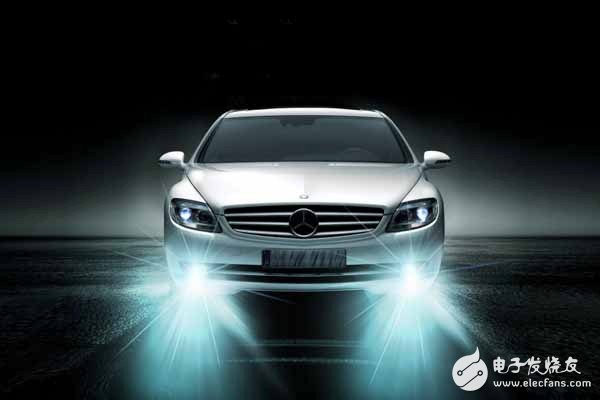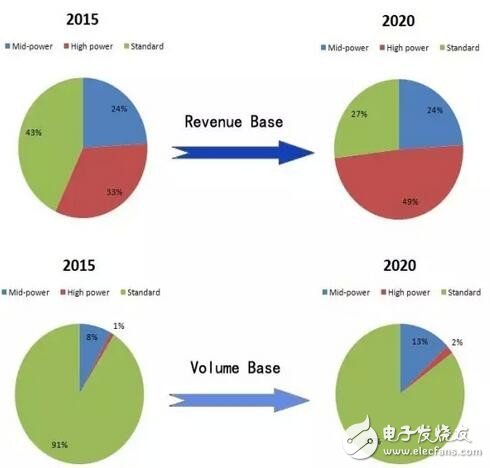In business talks, all are profit-seeking as "natural", LED manufacturers are of course "recognition of the time", watching the competition in the industry expand, they have to turn to niche-type applications. Now they are beginning to realize that the automotive LED field is one of the few blue ocean markets that can be maintained in quantity and price.
As long as there is a place for cars, there is a place for car lighting. We need to know what kind of blue-green market the car LED will be. Let's start with the current situation of the car market. According to the report "Global Automotive Parts Suppliers Research" released by consulting firm Roland Berger recently, the production of global light vehicles is expected to continue to rise in the next two years, but the growth rate will drop sharply. Among them, Europe will maintain a "lower level", Japan will "decline", the North American Free Trade Zone will "moderately grow", and the Chinese market will remain the only major growth driver.

In fact, relevant surveys show that the Chinese auto market in 2015 has slowed from the annual double-digit growth rate to 3%. The global auto market as a whole has a growth rate of only 1.6%. Although the situation in 2016 is not optimistic, it will continue the micro-growth trend in 2015, which is about 4% year-on-year. Both the SUV and the automotive aftermarket will maintain a strong momentum. In addition, during the period of 2014-2016, the new energy vehicle started an explosive growth period, with a compound annual growth of 42% in 2015-2020. By 2020, the penetration rate of new energy vehicles is expected to reach 4.5%.
On the other hand, foreign media recently reported that the global automotive LED lighting market is expected to reach 7 billion US dollars by 2020, with a compound annual growth rate of over 18%. Looking back at the situation of China's vehicle lamp supporting market, it has grown from RMB 17.8 billion in 2010 to RMB 25.5 billion in 2013. In 2015, China's automobile sales reached more than 31 million vehicles. According to this calculation, the corresponding vehicle lamp supporting market will also exceed 35 billion yuan, which makes it possible for the lamp companies to have good room for growth in the future.
By comparing the output value of the automotive lighting LED market in 2015 and 2020, Lu Lijun, an industrial analyst of Jibang Technology, also pointed out that the global LED output value of automotive exterior lighting is estimated to reach US$1.21 billion in 2015, reaching US$2.29 billion by 2020. The annual compound growth rate is 8%. Among them, the headlight module (near-light) LED package has the highest growth rate of output value, and the annual compound growth rate is 11%. The exterior lighting includes directional lights, fog lights, far and near lights and position lights. The growth in the number of high-power applications is higher than the annual price decline, driving the annual compound growth rate of output value to exceed 8%, and the penetration rate is less than 15%. It also reflects the future growth. According to its disclosure, the total number of LEDs for exterior lighting in 2015 reached 2.79 billion, and it is expected that there will be 3.67 billion in 2020. Among them, the number of LED packages of far and near lights and position lights is more than 15%, and the number of LED packages in the headlight module has the highest growth rate, with a compound annual growth rate of 23%.
In terms of the market value of LED lighting for interior lighting, it is estimated to reach US$605 million in 2015 and is expected to decline to 603 million US dollars in 2020. At the same time, due to the fact that most of the LEDs in the car are low-power LEDs, the overall in-vehicle output value will show negative growth in the next five years. The estimated annual growth rate of the interior panel of the car panel is 3%. According to the introduction, the LED package low, medium and high power respectively look at the changes in the output value of the LED package, the automotive low-power LED market will shrink rapidly in the next five years (2015-2020) (see the figure below). With the gradual shrinking of the output value of low-power chips in LED packaging, high-power chips will show rapid growth, and it is expected that automotive LED applications will actively enter the high-power market in the future.

Although it is estimated that the output value of the LED market for interior lighting will decline in 2020, the LED package of the interior panel will show a contrarian growth. According to statistics, the LED-related application panel will replace the mechanical instrument, and with the increase in the size of the central control panel, it is expected that the compound annual growth rate of the interior panel of the vehicle will be 3%.

It is understood that in the automotive market, halogen lamps are still the most popular light source because replacement costs are usually low. However, halogen bulbs generate about 2500 degrees of heat, so that headlights with halogen lamps as light sources have some optical design difficulties. HID gas mapping lamps provide a wider horizontal space and better energy efficiency.
Relevant research results show that high-quality high-end LED car headlights can enhance road safety, provide better visibility, reduce energy consumption and carbon dioxide emissions, and improve the appearance of the car, and its service life can be improved. Up to 25,000 hours. However, some people have pointed out that due to cost, technology and regulatory factors, LED as a car headlight is still immature, at least in the next three to five years can not fully replace halogen and xenon lamps. In this regard, the international large-scale technical investigation consultancy Technavio recently released the global automotive LED lighting market report that LED lights will gradually strengthen the safety and performance with the continuous development of innovative technology, and is expected to gradually reduce the price, then the automotive LED The sales of lamps will also gradually increase.
What is 5G CPE?
Definition of 5G CPE
CPE stands for Customer Premise Equipment. The so-called front end refers to the equipment in front of the customer's terminal equipment. When we use Wi-Fi, if the distance is far, or there are more rooms, it is easy to appear signal blind spots, resulting in mobile phones or ipads or computers can not receive Wi-Fi signals. The CPE can relay the Wi-Fi signal twice to extend the coverage of Wi-Fi.
What are the benefits of CPE?
Through the following comparison table, it is not difficult to understand the technical advantages of CPE products:
* Currently, the global 5G FWA service is mainly in the Sub-6GHz band, with only the United States and Italy supporting the millimeter wave band.
* 5G CPE integrates the low cost of Wi-Fi and the large bandwidth of 5G, combining the advantages of the two to form a strong complement to traditional fiber broadband.
The relationship between 5G, FWA and CPE
It can be said that FWA (Fixed Wireless Access) will be the most down-to-earth application of 5G technology. FWA business plays a key role in enabling "connecting the unconnected." FWA is a low-cost, easy-to-deploy flexible broadband solution. Compared with wired access technology, FWA has been an ideal choice for deploying broadband in many countries and regions because it does not need to obtain rights of way, dig trenches and bury cables, and drill holes through walls. The development of 5G technology is further promoting the development of FWA.
FWA services (including 4G and 5G) have reached 100 million users. FWA is no longer a niche service; The FWA industry as a whole has been supported by numerous suppliers. Why is that? In the 5G era, 5G CPE receives 5G signals from operator base stations and then converts them into Wi-Fi signals or wired signals to allow more local devices to get online. For operators, the initial user penetration rate of 5G is low, and the investment is difficult to realize quickly; The CPE business can use the idle network to increase revenue for operators, so major operators vigorously promote the development of 5G CPE.
FWA services can be used for both home (To C) and business (To B), and customers have different requirements for CPE devices when using FWA services in different application environments, resulting in consumer grade 5G CPE and industrial grade 5G CPE (similar to home routers and industrial routers).
In 2020, the global market size of 5G CPE will reach 3 million units, and it is expected that in the next five years, the market size of 5G CPE will maintain a compound growth rate of more than 100%, reaching 120 million units in 2025, with a market value of 60 billion yuan. As an important market for 5G CPE, China's 5G CPE market size will reach 1.5 million units in 2020 and is expected to reach 80 million units in 2025, with a market value of 27 billion yuan.
The difference between 5G CPE and other devices
CPE can support a large number of mobile terminals that access the Internet at the same time, and the device can be directly inserted with a SIM card to receive mobile signals. CPE can be widely used in rural areas, cities, hospitals, units, factories, communities and other wireless network access, can save the cost of laying wired networks.
A Router is a hardware device that connects two or more networks, acts as a gateway between networks, and is the main node device of the Internet. Routers use routes to determine the forwarding of data. If it is a home router, it does not support a SIM card slot, and can only receive signals by connecting to optical fiber or cable and then convert it into WI-FI to provide a certain number (several) of terminal devices to surf the Internet.
Industrial 5G CPE is equivalent to 5G industrial routers, and the technology of the two is not very different. On the one hand, the industrial 5G CPE converts 5G network signals into WiFi signals for transmission, and on the other hand, the data received by the WiFi network is converted into 5G network signals for uploading. In addition, industrial 5G CPE generally supports routing functions.
5G CPE trends
According to a research report, after evaluating the products of some mainstream 5G CPE suppliers, many institutions believe that the development of 5G CPE products will continue in two aspects: one is to support mmWave and Sub-6 GHz at the same time; Second, the design will pay attention to humanized operation and installation. The industry development trend will accelerate the demand for 5G in the medical, education and manufacturing industries due to the epidemic, and 5G FWA will promote global 5G CPE shipments.
Wireless Cpe,4G Cat6 Cpe,Mifi 4G,Ufi 4G
Shenzhen MovingComm Technology Co., Ltd. , https://www.mcrouters.com